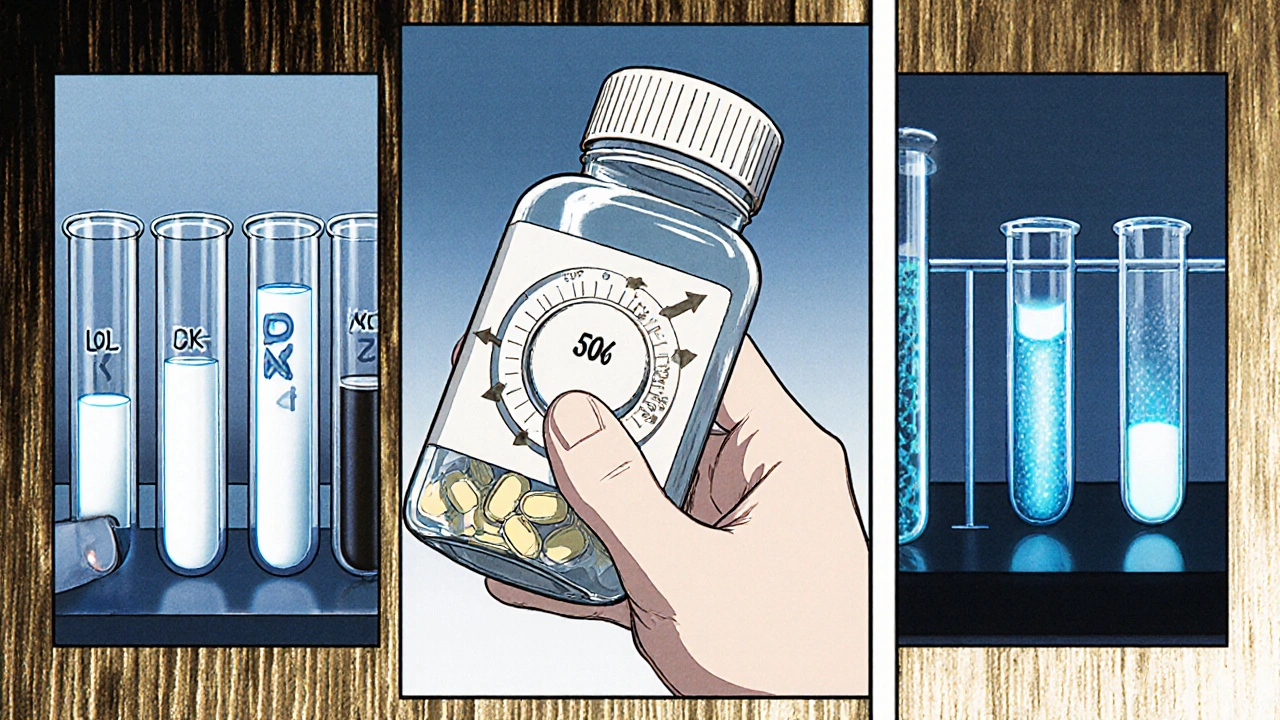Statin Discontinuation Guide: When to Stop & How to Manage Safely

Statin Discontinuation Risk Calculator
Patient Risk Factors
Risk Assessment Summary
Risk Estimate
Enter your information to see results
How This Works
Based on guidelines from American Geriatrics Society and recent studies, this calculator estimates annual cardiovascular event risk if statins are discontinued. Higher scores indicate greater risk of adverse events.
Personalized Recommendations
Enter information to see personalized recommendations based on clinical guidelines.
When you hear statin discontinuation is the process of stopping HMG‑CoA reductase inhibitor therapy, the first question is usually “Is it safe for me?” The answer depends on your heart risk, age, overall health, and why you started the drug in the first place. Below you’ll find a step‑by‑step roadmap that helps you decide if stopping makes sense, how to taper without surprises, and what to watch for after the last pill.
Key Takeaways
- Stopping is usually safe for patients with less than two years life expectancy or severe side‑effects.
- For secondary prevention, discontinuation adds about 1 extra major cardiovascular event per 77 people each year; for primary prevention the risk is 1 per 112.
- Gradual dose reduction, shared decision‑making, and close follow‑up cut relapse risk.
- Alternative lipid‑lowering options (PCSK9 inhibitors, ezetimibe, omega‑3) can fill gaps when appropriate.
- Document the reason, monitor labs, and reassess risk every 3-6 months.
Why Consider Stopping a Statin?
Statins have saved millions of lives by lowering LDL cholesterol, but they’re not free of drawbacks. The most common trigger for muscle‑related side effects (myopathy, cramps, or rare rhabdomyolysis) accounts for up to 87% of discontinuations in patients with documented adverse events. Other concerns include newly diagnosed diabetes, cognitive complaints, and the sheer burden of taking another daily pill-especially when you’re already juggling polypharmacy for conditions like hypertension, arthritis, or COPD.
Data from a 2013 study of 39 million U.S. adults showed that 19% stopped all statin therapy for at least a year. Hospital admissions, nursing‑home stays, and advanced cancers were strong predictors (adjusted odds ratios ranging from 2.1 to 3.3). In everyday practice, the decision often comes down to a personal weighing of long‑term heart protection versus short‑term quality‑of‑life impacts.
When Is It Clinically Appropriate to Stop?
Guidelines from the American Geriatrics Society and several deprescribing frameworks converge on three main scenarios:
- Limited life expectancy - If the prognosis is under two years, the absolute benefit of statins shrinks dramatically. Trials in hospice patients showed no short‑term mortality difference when statins were stopped.
- Severe or intolerable side effects - Persistent muscle pain, confirmed elevated CK levels, or new‑onset diabetes may justify discontinuation, especially after trying dose adjustments or switching to a different statin.
- Questionable benefit in primary prevention - Older adults without a history of cardiovascular disease often have a modest absolute risk reduction. Ongoing trials (e.g., “Discontinuing Statins in Multimorbid Older Adults”) suggest non‑inferiority for many in this group.
Conversely, patients with a recent myocardial infarction, established atherosclerotic disease, or a high 10‑year ASCVD risk (>20%) should think twice before stopping; the excess risk numbers from Thompson et al. (2021) are not trivial.

How to Stop Safely: A Practical Tapering Plan
Not every statin needs a gradual taper, but many physicians recommend it to avoid rebound cholesterol spikes and to give the body a chance to adjust. Here’s a generic roadmap; always tailor it with your clinician.
- Assess baseline labs: Check LDL‑C, CK, liver enzymes, and fasting glucose.
- Reduce the dose: Cut the current dose by half for 2-4 weeks. For long‑acting agents (e.g., rosuvastatin), a 50% dose reduction often suffices.
- Switch to a lower‑potency statin (optional): If muscle complaints persist, try pravastatin or fluvastatin at the lowest dose for another 4 weeks.
- Stop completely: After the taper period and if labs are stable, discontinue the final dose.
- Document the exact date and reason in the medical record.
- Set a reminder for a follow‑up lipid panel in 6-8 weeks.
For patients on high‑intensity regimens (e.g., atorvastatin 80 mg), a step‑down to a moderate‑intensity dose before stopping can reduce the risk of a sudden LDL surge, which has been linked to a short‑term increase in plaque vulnerability.
Alternatives and Adjuncts After Stopping
If you still need some lipid control, several non‑statin options exist:
- PCSK9 inhibitors (evolocumab, alirocumab) cut LDL by >60% and are injections given every 2-4 weeks. They’re pricey but often covered for high‑risk patients.
- Ezetimibe blocks cholesterol absorption in the gut; adds ~15% LDL reduction when used alone.
- Omega‑3 fatty acids (EPA/DHA) can improve triglycerides and have modest cardioprotective signals.
- Fibrates target high triglycerides but have limited LDL impact.
Switching to any of these should be guided by a risk calculator that incorporates age, blood pressure, smoking status, and existing disease. A shared‑decision tool from MyPCnow (2023) helps patients visualize the trade‑off between pill burden and projected event risk.
Monitoring After Discontinuation
Even after a clean break, keep an eye on these markers:
| Parameter | Timing | Action Threshold |
|---|---|---|
| LDL‑C | 6 weeks, then every 6 months | >130 mg/dL (consider alternative therapy) |
| CK (creatine kinase) | Baseline, then if muscle pain returns | >5× upper limit (re‑evaluate cause) |
| HbA1c | 3 months after stop (if diabetic risk) | >6.5% (consider lifestyle or meds) |
If LDL rises sharply, discuss re‑starting a low‑dose statin or adding a non‑statin as mentioned above. Many clinicians use the “stop‑and‑watch” approach for 3-6 months before deciding on re‑initiation.

Decision‑Making Checklist for Patients & Clinicians
- What is the primary reason for stopping? (side effects, limited life expectancy, low benefit)
- What is your current cardiovascular risk? (use ASCVD risk calculator)
- Are there alternative therapies that match your preference and budget?
- Do you have a support system (pharmacist, caregiver) to help monitor labs?
- Have you documented the plan and set follow‑up dates?
Answering yes to most of these questions usually signals that a thoughtful discontinuation is feasible.
Common Myths About Stopping Statins
- Myth: “You’ll immediately get a heart attack.” - Reality: Risk rises gradually; the excess 1‑in‑77 (secondary) or 1‑in‑112 (primary) events per year is an average, not a guarantee.
- Myth: “If I stop, my cholesterol will sky‑rocket forever.” - Reality: Levels often rebound to baseline within weeks but can be managed with diet or non‑statin meds.
- Myth: “Only older people need to think about stopping.” - Reality: Anyone who experiences intolerable side effects or has a changing health status should revisit the decision.
Next Steps If You’re Ready to Discuss Discontinuation
Schedule a medication review with your primary care doctor or a clinical pharmacist. Bring a list of all current drugs, recent lab results, and a brief note of any side effects you’ve noticed. During the visit, ask for a written taper plan, set lab follow‑up dates, and request documentation of the reason for stopping-this helps future clinicians understand the context.
How long should I wait before restarting a statin after stopping?
Most experts suggest waiting at least 6 weeks and confirming that LDL‑C has not risen dramatically. If you develop new cardiac symptoms during that window, discuss re‑initiation sooner.
Can I stop a high‑intensity statin without tapering?
It’s possible, but a step‑down reduces the chance of a sudden LDL surge and gives you time to notice any rebound symptoms. A 50 % dose cut for 2-4 weeks is a safe compromise.
What lifestyle changes help keep my cholesterol in check after stopping?
Focus on a Mediterranean‑style diet (olive oil, nuts, fish), regular aerobic exercise (150 min/week), weight management, and controlling blood pressure and blood sugar.
Are non‑statin drugs as effective as statins for heart protection?
PCSK9 inhibitors are the strongest non‑statin option, cutting LDL by up to 60 % and showing outcome benefits in high‑risk patients. Ezetimibe adds modest benefit when combined with other therapies.
What should I tell my pharmacist about stopping?
Ask the pharmacist to note the discontinuation reason in your medication record, review possible drug‑drug interactions for any new agents you start, and set reminders for follow‑up labs.

Pamela Clark
October 25, 2025 AT 19:29Oh, what a groundbreaking revelation-another guide on how to quit a pill that supposedly saves lives. Because we’ve all been on the brink of a cholesterol apocalypse, right? Let’s just toss the statin and hope the universe doesn’t explode.
Diane Holding
October 26, 2025 AT 11:09A clear step‑by‑step plan helps patients discuss options with their clinician and stay on track.
Manish Verma
October 27, 2025 AT 03:49Look, mates, if you’re over 75 and your life expectancy is under two years, stopping a statin isn’t just reasonable-it’s practically mandatory. The data you quoted backs that up, and no one likes unnecessary meds. Just make sure you keep monitoring your labs, or you’ll be blindsided later.
Lionel du Plessis
October 27, 2025 AT 20:29From a pharmacokinetic perspective the half‑life differential between rosuvastatin and pravastatin informs the tapering algorithm; a 50% dose reduction over 2–4 weeks aligns with receptor up‑regulation kinetics; clinicians should also consider LDL‑C rebound thresholds; monitoring CK and ALT remains non‑negotiable; patient adherence improves when the plan is gamified.
Greg Galivan
October 28, 2025 AT 13:09I dont buy that you can just cut the dose in half and hope for the best. The studies show a rebound effect that can increase event risk within weeks. If youre not tracking labs youre basically gambling with your heart.
ALBERT HENDERSHOT JR.
October 29, 2025 AT 05:49First and foremost, it is essential to recognize that statin therapy is a cornerstone of cardiovascular risk reduction, and any decision to discontinue should be grounded in shared decision‑making. When patients present with intolerable side effects, especially myopathy confirmed by elevated CK, a thoughtful taper can mitigate both physiological rebound and psychological distress. Start by obtaining a baseline lipid panel, liver enzymes, fasting glucose, and CK, documenting these values meticulously in the chart. Then, reduce the current dose by approximately 50 % for a period of two to four weeks, allowing the body to adjust to the lower exposure. For high‑intensity agents such as atorvastatin 80 mg, consider an intermediate step‑down to a moderate‑intensity dose before initiating the half‑dose phase. Throughout this process, schedule a follow‑up visit within six weeks to reassess LDL‑C trends and ensure that the patient’s symptoms have resolved. If LDL‑C creeps upward beyond the individualized target (often >130 mg/dL), discuss alternative lipid‑lowering strategies such as ezetimibe or a PCSK9 inhibitor, weighing cost and injection burden. Emphasize lifestyle modifications-adopt a Mediterranean diet rich in olive oil, nuts, and fatty fish, engage in at least 150 minutes of moderate aerobic activity per week, and maintain optimal blood pressure control. These non‑pharmacologic measures can blunt the LDL rebound that occasionally follows statin cessation. In patients with a limited life expectancy under two years, the absolute benefit of continued statin therapy diminishes, and the focus may shift toward quality‑of‑life considerations. Conversely, for secondary prevention in individuals with recent myocardial infarction or established atherosclerotic disease, the risk of stopping can be substantial, so a cautious, evidence‑based approach is warranted. Document the exact discontinuation date, the reason for stopping, and the agreed‑upon monitoring schedule in the medical record to aid future providers. Encourage patients to keep a symptom diary, noting any muscle aches, fatigue, or new cardiac symptoms, and to report these promptly. Remember that the psychological aspect of stopping a long‑term medication can be significant; provide reassurance and validate the patient’s concerns. Finally, reiterate that re‑initiation of a low‑dose statin remains an option if lipid levels become uncontrolled or if cardiovascular events occur. 😊
Donal Hinely
October 29, 2025 AT 22:29Listen up, folks-if you’ve been slamming a high‑intensity statin every day for years, you’re not a robot, you’re a human being with a pulse that deserves respect. Dumping that pill without a plan is like pulling the brakes on a speeding train without looking at the tracks. The rebound LDL surge can be brutal, and you’ll feel every ounce of that in your arteries. So either taper wisely or swap to a non‑statin powerhouse that won’t leave you gasping for breath.
christine badilla
October 30, 2025 AT 15:09My heart skips a beat just thinking about dropping that mighty statin!
Andrae Powel
October 31, 2025 AT 07:49When you decide to stop a statin, keep a close eye on your lipid profile every six weeks initially, then every six months if stable. Also, re‑check CK if you notice any muscle soreness, and monitor fasting glucose in case diabetes risk creeps up. Pair these labs with a heart‑healthy diet and regular exercise to sustain the benefits you’ve earned. If LDL rises sharply, discuss adding ezetimibe or a PCSK9 inhibitor with your doctor.
Leanne Henderson
November 1, 2025 AT 00:29Wow-what a comprehensive guide, really, it covers everything, from tapering schedules, to alternative therapies, to monitoring protocols!! I especially love the checklist format, it makes the whole process feel so organized, and the emphasis on shared decision‑making is just brilliant!!!
Suzanne Carawan
November 1, 2025 AT 17:09Sure, because adding another injection is exactly what everyone wants after quitting a daily pill. If you enjoy paperwork, you’ll love the insurance approvals for PCSK9 inhibitors.